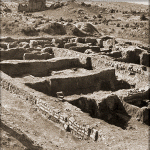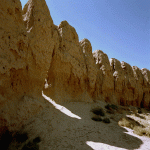Old Termez –Tarmitha
Termez takes its place among those cities of Central Asia whose genesis and evolution occurred in several places, whose cultural layers, reflecting all the phases of their existence, were acc umulated one after another, showing the unbroken sweep of the epochs.
Termez is considered as one of the most ancient cities that significantly contributed to the development of the Great Silken road which was a crossroad of world civilization. One of its branches passed through Termez. The most ancient names of the city were Taramaetha (sansckrit word meaning “on the other side of the river”), Da-mi, Antiochus-Tarmita, Dermit , Termiz.
This beautiful city had been found in the middle of the 1st millennium B.C. on a crossing of the Amudarya-Oxus River and was very important in the history of a number of Central Asian empires of the ancient and medieval periods. The location of the town on a strategically important section of the river, at the crossing of the trade roads going from south to north and from the east to west, caused its rapid growth.
In the course of more than several millenniums the water of the Amudarya River which is still a main provider of Fish in the region reached legendary Khorezm.
From the period of Greeko-Bactrian king Demetrius (200-185 B.C.) the increase of settlement in the place of Old Termez especially its citadel started. The conquest of North-western India (Gandhara)by Demetrius , apparently Sogdiana made a considerable extent to it and more convenient way to this region passed through Termez. By that Demetrius united two far regions of his kingdom – Gandhara and Sogdiana, the most important intermediate point between them was Termez and very convenient cross through the Oxus.
Subsequent Greeko –Bactrian rulers Agafoclus, Euphradithis, Helioclus, loosing Sogdiana, but keeping Bactria and Gandhara , continued paying more attention to Termez, in spite of all the vicissitudes of life, the main road linking India and Central Asia as usually passed through Termez.
Thus, in the early stages of existence important functions of Termez were defined which were conducive to its significance and flourishing – the protection of the most important crossing through the Oxus and serving to numerous caravans going through.
Yuechji- tokhari, who created the great empire of Kushanids, by their military power were equal to China, Rome and Parthia, were well aware of Termez’s value. Termez as the neighboring Kampirtepa , besides the roads going to the north controlled the most important trade routes leading from India along the valley of the Oxus- Amudarya to Margiana and Parthia and then through the Caspian sea to outfalls of Riona (where the modern Georgian city Poti located ) and along the Black Sea to Roman possessions. About the existence of this road through which the most important goods were passed wrote a roman writer Pliniy from the citations of Varrona. Strabon and scientists of antique period also wrote about it. After the collapse of Kushan Empire in early Middle Ages the outer and inner trade developed very slowly.
In the IX c and the beginning of XIII centuries inner and outer trade had been widely developed in this connection the level of development of commodity-money relations here was very high. One of the factors of urban life flourishment in Termez was international trade. The favorable location of the city at the crossroads of trade routes of interregional character was conducive to this which is confirmed in the written sources. Particularly, the author of “Hudud ul-alam” mentioned that Termez was considered as trade centre of Huttalan and Chaghanian. Consequently, it should be noted that importation of foreign goods or export of which were carried out through Termez. Termez treasury received quite large income from interregional caravan trade for which a big number of caravan-sarais were constructed. Termez traded not only on land but also on the river. At those times it was the biggest port city on the Amudarya. According to Maqsidi, ships sailed into the port cities from different sides. Big and small ships loaded with various goods from Termez port sailed upper and downstream along the Amudarya until the cities in Khorezm.
Termez was not only a transit city of interregional trade but it actively participated in this trade with its products. Undoubtedly, not all the products of Termez artisans had been designed for the needs of the urban population as certain part of it was exported far beyond the city to neighboring pastoral areas. According to Maqsidi, asafetida, soup and boats were exported from Termez. Asafetida was used in medicine for curing hysteria and nerve paralytic disease. Moreover, asafetida was widely used in the Middle East and India as spice. Probably mass production of spheroconical dishes in Termez was related specially with the transportation of this material to far countries.




